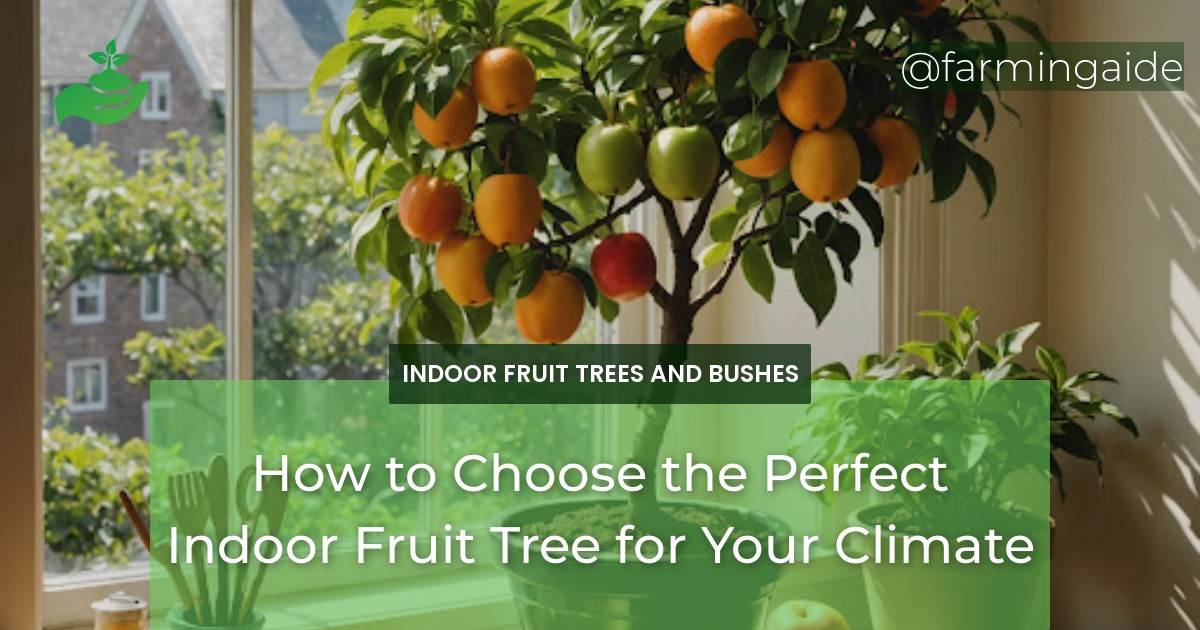Imagine walking into your living room and plucking a fresh, juicy apple from a tree that’s thriving right in your own home. Sounds like a dream, doesn’t it? With the right indoor fruit tree, it can be a reality! However, choosing the perfect tree for your climate can be daunting, especially for beginners. That’s why we’ve put together this comprehensive guide to help you select the ideal indoor fruit tree for your climate and provide the necessary care to enjoy a bountiful harvest. When deciding on the right indoor fruit tree for your home, consider factors such as the amount of sunlight and humidity in your living space. Some popular indoor fruit trees include citrus trees, fig trees, and dwarf apple or pear trees. By selecting the appropriate tree for your climate and learning the proper care techniques, you can enjoy the sweet rewards of growing your own indoor fruit trees.
Key Takeaways
- Identify your local climate zone to choose the right indoor fruit tree
- Consider factors like temperature, humidity, and light exposure when selecting a tree
- Popular indoor fruit trees include tropical, temperate, and dry climate options
- Proper care involves watering, fertilizing, pruning, and pest management
- Enjoy the fruits of your labor with proper harvesting and storage techniques
Understanding Your Climate
Before choosing an indoor fruit tree, it’s essential to understand your local climate. Climate plays a significant role in determining which trees will thrive indoors. Start by identifying your local climate zone, which can be done by checking online resources or consulting with local nurseries.
Once you know your climate zone, research the specific needs of different fruit trees. Some trees, like citrus and avocados, thrive in warm, humid environments, while others, like apples and pears, prefer cooler, more temperate climates.
Identifying Your Local Climate Zone
Climate zones are typically categorized into tropical, temperate, and dry climates. Tropical climates are characterized by high temperatures and high humidity, while temperate climates have moderate temperatures and humidity. Dry climates, on the other hand, are marked by low humidity and extreme temperatures.
Use the following table to identify your local climate zone:
| Climate Zone | Characteristics |
|---|---|
| Tropical | High temperatures (above 64°F/18°C), high humidity |
| Temperate | Moderate temperatures (32°F/0°C to 64°F/18°C), moderate humidity |
| Dry | Low humidity, extreme temperatures (below 32°F/0°C or above 90°F/32°C) |
Key Climate Factors for Indoor Fruit Trees
When selecting an indoor fruit tree, consider the following climate factors:
- Temperature: Most fruit trees prefer daytime temperatures between 65°F/18°C and 75°F/24°C, and nighttime temperatures 5-10°F/3-6°C lower.
- Humidity: Fruit trees prefer a relative humidity of 40-60%.
- Light exposure: Most fruit trees require bright, indirect light, but some can tolerate direct sunlight.
Popular Indoor Fruit Trees by Climate
Now that you understand your climate, let’s explore popular indoor fruit trees for each climate zone:
ALSO READ
Tropical Climate Choices
Tropical climates are ideal for fruit trees like:
- Avocado (Persea americana)
- Banana (Musa acuminata)
- Mango (Mangifera indica)
These trees thrive in high temperatures and humidity, making them perfect for tropical climates.
Temperate Climate Choices
Temperate climates are suitable for fruit trees like:
- Apple (Malus domestica)
- Pear (Pyrus communis)
- Fig (Ficus carica)
These trees prefer moderate temperatures and humidity, making them ideal for temperate climates.
ALSO READ
Dry Climate Choices
Dry climates are suitable for fruit trees like:
- Dwarf Washington Navel Orange (Citrus sinensis)
- Dwarf Pomegranate (Punica granatum)
- Olive Tree (Olea europaea)
These trees are adapted to low humidity and extreme temperatures, making them perfect for dry climates.
Selecting the Right Fruit Tree
When selecting an indoor fruit tree, consider the following factors:
Size and Space Considerations
Choose a tree that fits your available space. Dwarf or compact varieties are ideal for indoor growing.
Measure the space where the tree will be placed, taking into account the mature size of the tree.
Light Requirements
Consider the light exposure in your home. South-facing windows receive direct sunlight, while north-facing windows receive indirect light.
Choose a tree that matches your available light conditions.
Maintenance Needs
Some fruit trees require frequent pruning, while others need regular fertilization.
Choose a tree that fits your maintenance schedule and skills.
Caring for Your Indoor Fruit Tree
Proper care is essential for a thriving indoor fruit tree:
Watering and Fertilizing
Water your tree when the top 1-2 inches of soil feel dry to the touch.
Fertilize your tree during the growing season (spring-fall) with a balanced fertilizer.
Pruning and Training
Prune your tree regularly to maintain shape, promote fruiting, and remove diseased or damaged branches.
Train your tree to a trellis or stake to maintain a compact shape.
Pest and Disease Management
Monitor your tree regularly for pests like mealybugs, spider mites, and scale.
Use organic or chemical controls to address infestations promptly.
Conclusion: Enjoying Your Homegrown Fruits
Congratulations! With the right indoor fruit tree and proper care, you’ll be enjoying fresh, delicious fruits right in your own home.
Harvesting Tips
Harvest fruits when they’re ripe to ensure optimal flavor and texture.
Use the following table to determine the ripeness of common fruits:
| Fruit | Ripeness Indicators |
|---|---|
| Apple | Soft to the touch, sweet aroma, slight give when pressed |
| Orange | Heavy for its size, sweet aroma, slight softening of skin |
| Banana | Yellow skin, slight softening of skin, sweet aroma |
Enjoying the Fruits of Your Labor
Enjoy your fresh, homegrown fruits in salads, smoothies, or as a healthy snack.
Share your harvest with friends and family, or preserve fruits through canning, freezing, or dehydrating.


